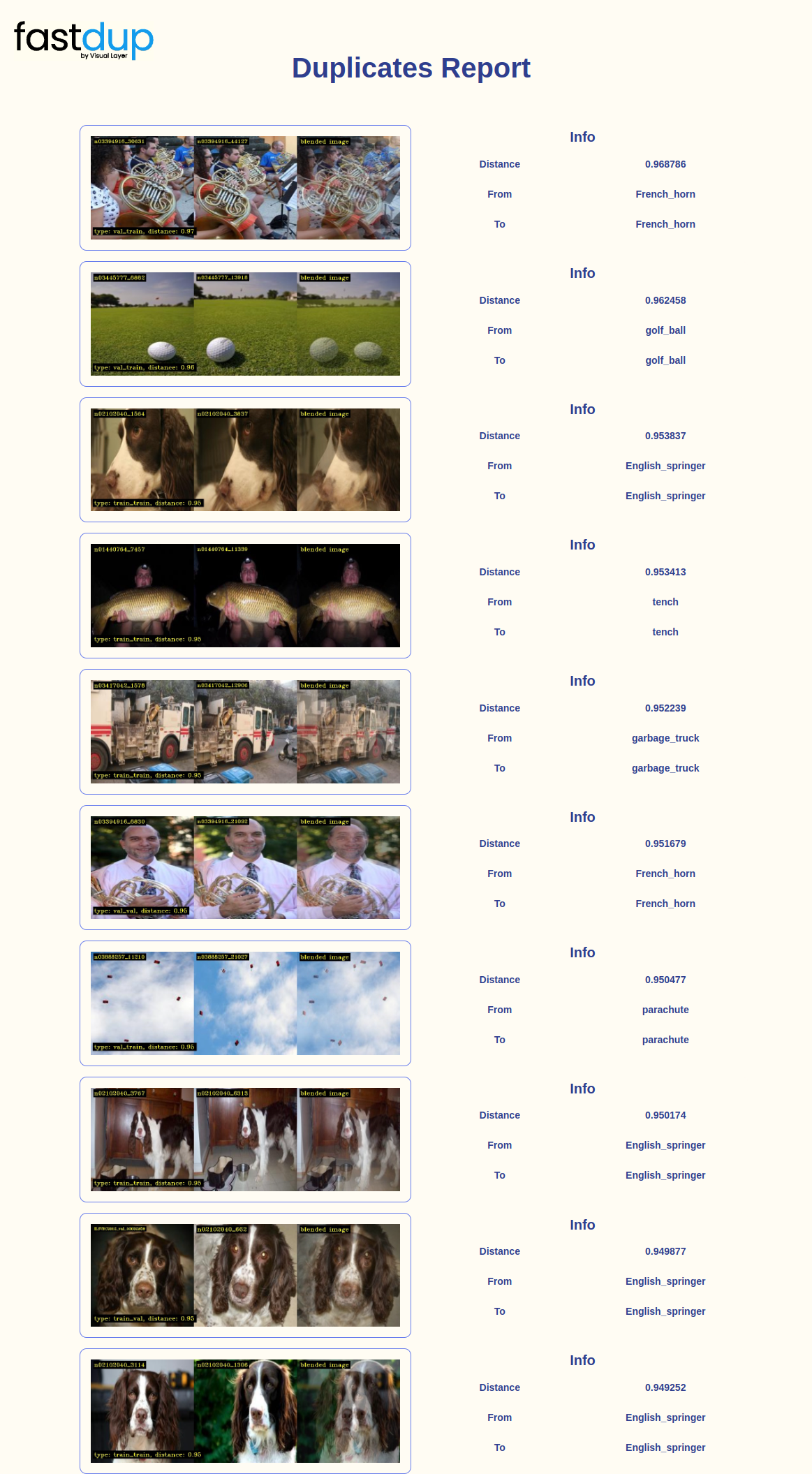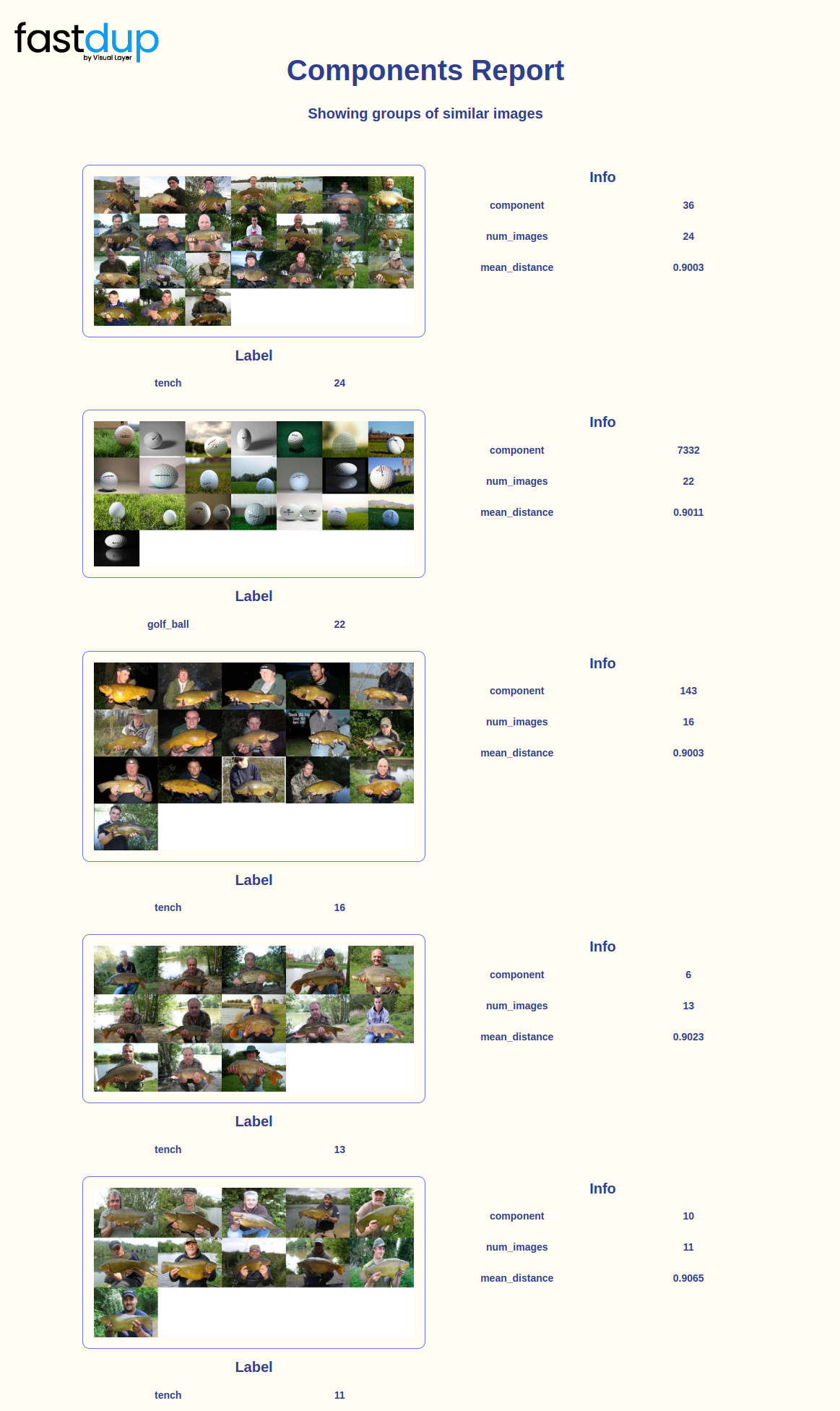Analyzing Image Classification Dataset
In this tutorial we use fastdup to analyze a labelled image classification dataset for potential issues.
By the end of this tutorial you'll learn how to:
- Load and format annotations in fastdup.
- Compare labels of similar images.
- Visualize a subset of the dataset using its labels.
Setting Up
You can follow along this tutorial by running this notebook on Google Colab.
First, install fastdup with:
pip install fastdupAnd verify the installation.
import fastdup
fastdup.__version__This tutorial runs on version 0.906.
Download Dataset
We will be analyzing the Imagenette dataset - A 10-class ImageNet subset from fast.ai.
Imagenette consists of 10 classes from the original ImageNet dataset. It contains 13k images in total.
Download and extract dataset:
!wget https://s3.amazonaws.com/fast-ai-imageclas/imagenette2-160.tgz
!tar -xzf imagenette2-160.tgzOnce done you should have a folder with the following structure.
./imagenette2-160/
├── noisy_imagenette.csv
├── train
│ ├── n01440764
│ ├── n02102040
│ ├── n02979186
│ ├── n03000684
│ ├── n03028079
│ ├── n03394916
│ ├── n03417042
│ ├── n03425413
│ ├── n03445777
│ └── n03888257
└── val
├── n01440764
├── n02102040
├── n02979186
├── n03000684
├── n03028079
├── n03394916
├── n03417042
├── n03425413
├── n03445777
└── n03888257
Naming
noisy_imagenette.csv- A.csvfiles with labels.train/- Train images.val/- validation images.
Load & Format Annotations
We'll use pandas to load and format the annotations.
import pandas as pd
data_dir = 'imagenette2-160/'
csv_path = 'imagenette2-160/noisy_imagenette.csv'As ImageNet uses codes for classes, we'll map them to their human readable values for ease of analysis (source):
label_map = {
'n02979186': 'cassette_player',
'n03417042': 'garbage_truck',
'n01440764': 'tench',
'n02102040': 'English_springer',
'n03028079': 'church',
'n03888257': 'parachute',
'n03394916': 'French_horn',
'n03000684': 'chain_saw',
'n03445777': 'golf_ball',
'n03425413': 'gas_pump'
}Let's load the annotations.
df_annot = pd.read_csv(csv_path)
df_annot.head(3)| path | noisy_labels_0 | noisy_labels_1 | noisy_labels_5 | noisy_labels_25 | noisy_labels_50 | is_valid | |
|---|---|---|---|---|---|---|---|
| 0 | train/n02979186/n02979186_9036.JPEG | n02979186 | n02979186 | n02979186 | n02979186 | n02979186 | False |
| 1 | train/n02979186/n02979186_11957.JPEG | n02979186 | n02979186 | n02979186 | n02979186 | n03000684 | False |
| 2 | train/n02979186/n02979186_9715.JPEG | n02979186 | n02979186 | n02979186 | n03417042 | n03000684 | False |
Transform the annotation into a format expected by fastdup.
# take relevant columns
df_annot = df_annot[['path', 'noisy_labels_0']]
# rename columns to fastdup's column names
df_annot = df_annot.rename({'noisy_labels_0': 'label', 'path': 'img_filename'}, axis='columns')
# create split column
df_annot['split'] = df_annot['img_filename'].apply(lambda x: x.split("/")[0])
# map label ids to regular labels
df_annot['label'] = df_annot['label'].map(label_map)
# show formated annotations
df_annot.head()| img_filename | label | split | |
|---|---|---|---|
| 0 | train/n02979186/n02979186_9036.JPEG | cassette_player | train |
| 1 | train/n02979186/n02979186_11957.JPEG | cassette_player | train |
| 2 | train/n02979186/n02979186_9715.JPEG | cassette_player | train |
| 3 | train/n02979186/n02979186_21736.JPEG | cassette_player | train |
| 4 | train/n02979186/ILSVRC2012_val_00046953.JPEG | cassette_player | train |
Run fastdup
With the annotations and folders in the right format, let's run fastdup and analyze the dataset.
import fastdup
work_dir = 'fastdup_imagenette'
fd = fastdup.create(work_dir=work_dir, input_dir=data_dir)
fd.run(annotations=df_annot, ccthreshold=0.9, threshold=0.8)
Info
ccthreshold- Threshold to use for the graph connected component. Default is 0.96.threshold- Threshold to use for the graph generation. Default is 0.9.
Get a summary of the run.
fd.summary()Dataset Analysis Summary:
Dataset contains 13394 images
Valid images are 100.00% (13,394) of the data, invalid are 0.00% (0) of the data
Similarity: 2.73% (366) belong to 20 similarity clusters (components).
97.27% (13,028) images do not belong to any similarity cluster.
Largest cluster has 40 (0.30%) images.
For a detailed analysis, use `.connected_components()`
(similarity threshold used is 0.8, connected component threshold used is 0.9).
Outliers: 6.20% (830) of images are possible outliers, and fall in the bottom 5.00% of similarity values.
For a detailed list of outliers, use `.outliers()`.
['Dataset contains 13394 images',
'Valid images are 100.00% (13,394) of the data, invalid are 0.00% (0) of the data',
'Similarity: 2.73% (366) belong to 20 similarity clusters (components).',
'97.27% (13,028) images do not belong to any similarity cluster.',
'Largest cluster has 40 (0.30%) images.',
'For a detailed analysis, use `.connected_components()`\n(similarity threshold used is 0.8, connected component threshold used is 0.9).\n',
'Outliers: 6.20% (830) of images are possible outliers, and fall in the bottom 5.00% of similarity values.',
'For a detailed list of outliers, use `.outliers()`.']
830 possible outliersFrom the summary there are 830 possible outliers found. Let's inspect them further!
Outliers
Let's visualize the outliers in the dataset.
fd.vis.outliers_gallery()
Label informationNote the label information in the outliers report.

Anomalies?Can you spot any anomalies from the report?
Hint -
parachuteandgolf ball.
To get more details on the outliers, run:
fd.outliers().head()| index | outlier | nearest | distance | img_filename_outlier | label_outlier | split_outlier | error_code_outlier | is_valid_outlier | img_filename_nearest | label_nearest | split_nearest | error_code_nearest | is_valid_nearest | |
|---|---|---|---|---|---|---|---|---|---|---|---|---|---|---|
| 0 | 1338 | 12009 | 1757 | 0.469904 | val/n03417042/n03417042_29412.JPEG | garbage_truck | val | VALID | True | train/n02102040/n02102040_7256.JPEG | English_springer | train | VALID | True |
| 1 | 1336 | 2664 | 9763 | 0.476124 | train/n02979186/n02979186_3967.JPEG | cassette_player | train | VALID | True | val/n01440764/n01440764_710.JPEG | tench | val | VALID | True |
| 2 | 1335 | 2727 | 1571 | 0.476313 | train/n02979186/n02979186_5424.JPEG | cassette_player | train | VALID | True | train/n02102040/n02102040_536.JPEG | English_springer | train | VALID | True |
| 3 | 1333 | 12172 | 1817 | 0.479290 | val/n03417042/n03417042_91.JPEG | garbage_truck | val | VALID | True | train/n02102040/n02102040_7868.JPEG | English_springer | train | VALID | True |
| 4 | 1332 | 1981 | 10098 | 0.479516 | train/n02979186/n02979186_10387.JPEG | cassette_player | train | VALID | True | val/n02102040/n02102040_5272.JPEG | English_springer | val | VALID | True |
Similarity Gallery
Other than the outliers, we can find possible mislabels by comparing a query image to other images in the dataset.
This can be done with:
fd.vis.similarity_gallery() 
To get a detailed information
fd.similarity().head(5)| from | to | distance | img_filename_from | label_from | split_from | error_code_from | is_valid_from | img_filename_to | label_to | split_to | error_code_to | is_valid_to | |
|---|---|---|---|---|---|---|---|---|---|---|---|---|---|
| 0 | 11521 | 5390 | 0.968786 | val/n03394916/n03394916_30631.JPEG | French_horn | val | VALID | True | train/n03394916/n03394916_44127.JPEG | French_horn | train | VALID | True |
| 1 | 5390 | 11521 | 0.968786 | train/n03394916/n03394916_44127.JPEG | French_horn | train | VALID | True | val/n03394916/n03394916_30631.JPEG | French_horn | val | VALID | True |
| 2 | 12914 | 7715 | 0.962458 | val/n03445777/n03445777_6882.JPEG | golf_ball | val | VALID | True | train/n03445777/n03445777_13918.JPEG | golf_ball | train | VALID | True |
| 3 | 7715 | 12914 | 0.962458 | train/n03445777/n03445777_13918.JPEG | golf_ball | train | VALID | True | val/n03445777/n03445777_6882.JPEG | golf_ball | val | VALID | True |
| 4 | 1117 | 1404 | 0.953837 | train/n02102040/n02102040_1564.JPEG | English_springer | train | VALID | True | train/n02102040/n02102040_3837.JPEG | English_springer | train | VALID | True |
Duplicates
Let's also check for duplicate pairs.
fd.vis.duplicates_gallery()
Image Clusters
fd.vis.component_gallery(num_images=5)
You can also visualize clusters with specific labels using the slice parameter. For example let's visualize clusters with the chain_saw label.
fd.vis.component_gallery(slice='chain_saw')
Summary
We now added several important label-specific features to run on top of the raw datasetBuilding over the image dataset analysis conducted without labels in the Cleaning and preparing a dataset tutorial, we've seen how to further slice the data and visualize specific classes of interest.
Updated 7 months ago
Next we will dive into a dataset labeled with bounding boxes, first analyzing the distribution and individual classes, and then finding outliers and possible mislabels, in preparation for training a model

